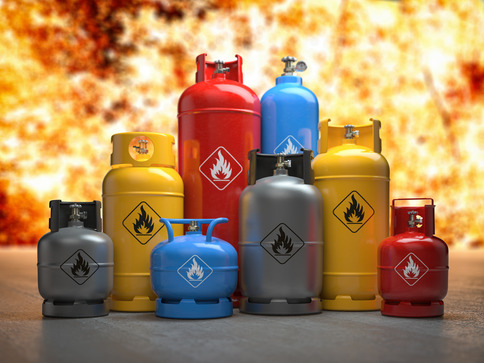“Don’t learn safety by accident”
This is a common theme in safety critical industries such as a nuclear power plant. Like nuclear power, LPG bottling plants are also mere one step away from a accident; the cost associated with an accident in the LPG Industry can be huge:
- Direct cost – Personnel & equipment loss,
- Indirect cost – Production delay & reputation damage.
Therefore, a great amount of proactive effort, day-after-day is required by all stakeholders to ensure risk is always averted by using LPG Safe products and processes in a bottling plant operation.
Fire Triangle
Fire Triangle is a simplified model to understand important ingredients for most fires. The three main elements of a fire triangle are:
- Fuel,
- Oxygen,
- Heat.
In the LPG environment, two primary components of the fire triangle, namely oxygen and fuel are readily available, 100% of the time, and only heat source is needed to start a fire / explosion. To prevent such a situation, filling plants around the world ground their trucks and earth the conveying systems to avoid any spark discharge; yet we hear cases of accidents in bottling plant operations.
Static Discharge – the Hidden Hazard
With LPG, hazards occur during:
- Transportation of LP Gas in cylinders or bulk
- Operations & Handling of LP Gas
- Storage in cylinders or bulk
While a gas leak is a known and commonly addressed hazard, static charge build up and its measures for dissipation gets overlooked in practice. The heat associated with a small static discharge can be sufficient to start a fire or explosion in the Liquefied petroleum Gas environment.
One common source of static charge in an LPG bottling plant is the plastic wear strips or liners used in conveying system to reduce frictional forces with conveyor chains.
Filling plants procure Teflon or nylon wear strips believing they are anti-static materials as they are black in color. Not many realize that majority of the polymer grades of Nylon, Teflon, polyethylene and polycarbonate materials have low surface resistivity; making them susceptible to static build up, and inability to dissipate static charge that is build up in the environment. Thus, choosing a right grade of anti-static wear liners is very important. It not only prevents from generating a static charge, but also helps in dissipating the charge to eliminate any hazards.
Anti-static wear strips from Jasma are rated (and ideal) for explosion environment, and can eliminate static charge build-up, and provide peace of mind. Similar use of anti-static materials during transportation, handling and storage can reduce other hazards as well.
The irony is that many times a common plastic hair comb is not allowed in the LPG bottling plants due to the fear of static electricity, but then many products and spares are sourced that do not have anti-static properties.
Contact us TODAY at [email protected] to know more about our products for LPG safe environments.

